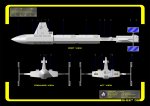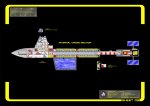History of the USS Storm
HISTORY OF THE USS STORM
– By David Sladky
It is a long and varied history, spanning two decades and lots of time, energy and fun, but for the most part, it can be counted on as a testament of the staying power of both Star Trek and being a Star Trek fan. In 1991, the Sands Hotel in Atlantic City, New Jersey, held its first ever Star Trek Convention called StarCon. It was a huge success and it introduced me to the world of Star Trek fandom. Until that time I had been isolated from “TREKKERS” and really did not have any idea there were people out there who liked the same stuff I did. This was before the Internet and e-mail. Instant contact was a phone call if you were lucky. With this new excitement, I got in contact with a group called the IFT (International Federation of Trekkers) and decided to start my very own Star Trek club. The core group would be me, my brother Mike, Bill Shoemaker, Pablo Bermudas and Craig Baird. After a vote, the crew decided on the name STORM after the character Storm in Marvel comics. We were hard pressed to be able to do much, with almost no money, and very little in the way of getting uniforms or props, we relied on meeting and role-playing games to enjoy the Star Trek experience. It was shortly after that I discovered the IFT had not even listed us as a chapter, a few letters and a few phone calls should have sorted the matter out, but months later we were still not listed as a chapter. Seeing as we had been getting a long by ourselves all this time, we decided we didn’t need a big organization to pay dues too, so we went independent. This was a bold move that I would later regret, as not having any support for your group put all of the pressure on me as the Captain. After some power plays by the crew, I decided to step down as Captain and move over to Commodore, let the crew pick a new captain and help out as needed. Without the forward momentum we had, things soon fell into disarray and the STORM soon was more or less in dry-dock. From this point on, the ship and crew took many changes and time and again I tried to find a group that would fit us: Starfleet Marines International, the Special Security Division, Starfleet Command, the Federation, the United Federation of Planets International and maybe a few I have forgotten about over the years.
Then in October of 2009, a friend I made when I was Chief of Operations SMI, Larry Neigut, contacted me and asked if I was interested about starting up a chapter of STARFLEET. After the implosion of the last club I was in, I was not looking to get back into the grind of working on a group and being its’ leader. To be honest, it’s a real pain in the ass. But Larry was persuasive and with a lot of help from him we became a shakedown chapter attached to the USS Challenger. As we move on, I can only hope we make a powerful mark in the world and fandom as well as community service!
History of a Ship Named Storm
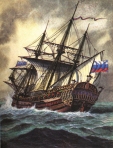 The Starship U.S.S. Storm follows in a line of history after other great ships named Storm. The following is a chronology of those ships, named in fiction, throughout the ages within the chronology of Star Trek.
The Starship U.S.S. Storm follows in a line of history after other great ships named Storm. The following is a chronology of those ships, named in fiction, throughout the ages within the chronology of Star Trek.
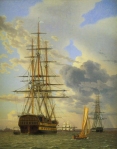 Шторм – Russian for “The Storm”. One of the fighting Brigantine within Peter the Great of Russia’s fleet, that battles with the Swedish Navy within the 17th Century. Mounting 16 cannons (8 on each side) this ship sailed more like a Merchant vessel of the time but with only 80 crew members than the standard 100 like the Merchant. Peter the Great was renowned for his ship building skills and is credited with single-handedly building his fleet’s flagship.
Шторм – Russian for “The Storm”. One of the fighting Brigantine within Peter the Great of Russia’s fleet, that battles with the Swedish Navy within the 17th Century. Mounting 16 cannons (8 on each side) this ship sailed more like a Merchant vessel of the time but with only 80 crew members than the standard 100 like the Merchant. Peter the Great was renowned for his ship building skills and is credited with single-handedly building his fleet’s flagship.
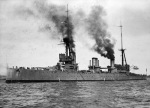 HMS Storm – In the mid 18th Century, the British adopted the name, Storm, for one of its third-rate Man-O-War. Serving as a “Ship of the Line” for the Royal Navy, her 80 guns saw campaigns in North Africa, East Indies, Mediterranean, and the coast of North America. She lived out her days in obscurity as just another ship of the line for his Majesty the King.
HMS Storm – In the mid 18th Century, the British adopted the name, Storm, for one of its third-rate Man-O-War. Serving as a “Ship of the Line” for the Royal Navy, her 80 guns saw campaigns in North Africa, East Indies, Mediterranean, and the coast of North America. She lived out her days in obscurity as just another ship of the line for his Majesty the King.
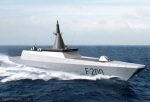 HMS Storm – Named after its 18th Century predecessor, the Royal Cruiser HMS Storm served with the North Sea Fleet protecting the straits between Scotland and the Orkney Islands during the First World War. She saw action when a squadron of German U-Boats tried to mine the straits and was caught by the Mine-Sweeping Fleet of the United States Navy during autumn of 1917. The HMS Storm was used as the lead battery in sinking four of the U-Boats.
HMS Storm – Named after its 18th Century predecessor, the Royal Cruiser HMS Storm served with the North Sea Fleet protecting the straits between Scotland and the Orkney Islands during the First World War. She saw action when a squadron of German U-Boats tried to mine the straits and was caught by the Mine-Sweeping Fleet of the United States Navy during autumn of 1917. The HMS Storm was used as the lead battery in sinking four of the U-Boats.
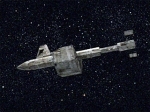 EUV Storm – The rest of the 20th Century did not see the name Storm listed as any nation’s ship. It was not until the middle of the 2020’s that a ship was commissioned Storm, serving in the European Union’s Naval Taskforce as a first strike vessel. Its mission was to protect vessels against attacking Pirate vessels during the Eugenic Wars.
EUV Storm – The rest of the 20th Century did not see the name Storm listed as any nation’s ship. It was not until the middle of the 2020’s that a ship was commissioned Storm, serving in the European Union’s Naval Taskforce as a first strike vessel. Its mission was to protect vessels against attacking Pirate vessels during the Eugenic Wars.
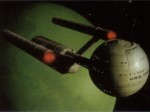 S.S. Storm – Named in honor of the preceding ship, EUV Storm, that was destroyed in an attack by 6 Pirate vessels while protecting a group of passenger liners along the coast of East Africa. She destroyed 5 of the Pirate ships before sinking herself. The S.S. Storm served as a long-range military sleeper ship until when she was decommissioned due to the advent of WARP travel.
S.S. Storm – Named in honor of the preceding ship, EUV Storm, that was destroyed in an attack by 6 Pirate vessels while protecting a group of passenger liners along the coast of East Africa. She destroyed 5 of the Pirate ships before sinking herself. The S.S. Storm served as a long-range military sleeper ship until when she was decommissioned due to the advent of WARP travel.
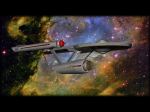 U.S.S. Storm – The Human / Romulan war was Humanities first interstellar conflict after more than forty years of total peace. Thus, while the Romulans began the war with a well-tested fleet of purpose designed combat vessels, the Humans where trying to hold them back with converted merchant vessels augmented by the occasional ship bought from an alien government. From the first day of the war it was obvious that a new class of warships was needed, ships that where larger, faster and more powerful than any which had preceded them. Work began at a feverish pace early in 2156, and by mid 2158 the first of the new Daedalus class was launched.
U.S.S. Storm – The Human / Romulan war was Humanities first interstellar conflict after more than forty years of total peace. Thus, while the Romulans began the war with a well-tested fleet of purpose designed combat vessels, the Humans where trying to hold them back with converted merchant vessels augmented by the occasional ship bought from an alien government. From the first day of the war it was obvious that a new class of warships was needed, ships that where larger, faster and more powerful than any which had preceded them. Work began at a feverish pace early in 2156, and by mid 2158 the first of the new Daedalus class was launched.
Primarily a combat vessel, the class was fitted with four laser cannon of the heaviest type in service and a magazine of twenty-four fusion missiles. Combined with her high-speed and enhanced shield capacity, the Daedalus was considered equal to any four Romulan warships. In service they proved exemplary, rapidly acquiring a fearsome reputation on the front lines. By 2159 the rapidly growing Daedalus fleet had turned the tide in the war, and by the end of that year they were routinely striking deep into Romulan home territory. The Romulans, faced with a war now fought almost wholly on their own territory, sued for peace in 2160.
The first of the Daedalus class vessels reached the end of its hull life in 2188. Initially it was planned to conduct a major overhaul on the hulls of the ships to extend their lives a further twenty years, but with a lessening in tensions during this period it was decided that Starfleet needed fewer heavily armed ships in service. The number of Daedalus class ships was allowed to gradually fall as ships reached the end of their hull life and retired. Initially it was planned to retire the crusier-type altogether in favour of large numbers of smaller, more maneuverable vessels. But in the end it was decided to put most of the Daedalus fleet into mothballs against possible future need. The last one hundred ships were placed in storage in 2196, with the USS Storm being that last ship.
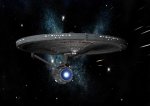 U.S.S. Storm – Perhaps the most famous class of vessel in Starfleet history, the Constitution class was a legend in its own time. When launched, the U.S.S. Constitution set a new standard of excellence in almost every applicable field – she was simultaneously the fastest ship, most advanced exploration platform and most powerful combat vessel in known space. The four hundred and thirty crew members of the U.S.S. Storm enjoyed a standard of crew accommodation unknown on other vessels of the period, while the diplomatic facilities rivaled those of all but the most elaborate Starbases.
U.S.S. Storm – Perhaps the most famous class of vessel in Starfleet history, the Constitution class was a legend in its own time. When launched, the U.S.S. Constitution set a new standard of excellence in almost every applicable field – she was simultaneously the fastest ship, most advanced exploration platform and most powerful combat vessel in known space. The four hundred and thirty crew members of the U.S.S. Storm enjoyed a standard of crew accommodation unknown on other vessels of the period, while the diplomatic facilities rivaled those of all but the most elaborate Starbases.
Quickly following the Constellation in 2245 was the rest of the Constitution class starships. During her years of service life the Storm explored countless new worlds, making first contact with many species and helped in expanding the Federations knowledge of the territories surrounding it hugely. Like her sister starships the U.S.S. Storm also served as a mighty deterrent to both the Klingons and Romulans, several times taking part in combat actions which helped determined the fate of the entire Federation if not the Alpha Quadrant itself.
